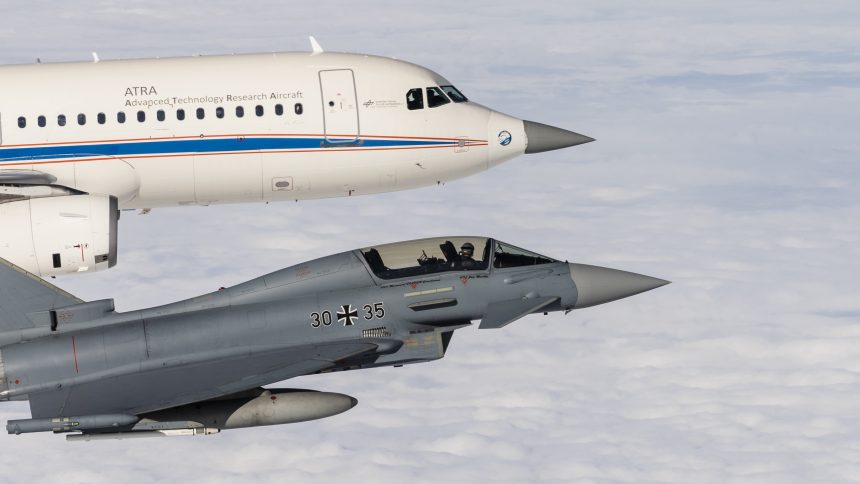The Advanced Technology Research Aircraft was modified with the Eurofighter’s nose to support testing of the ECRS Mk.1 AESA radar.
Airbus and the German Aerospace Center (DLR) have reached another milestone with the modified Airbus A320 Advanced Technology Research Aircraft (ATRA) recently flying in its Initial Operational Capability (IOC) configuration, after the first flight earlier this year. This will be used to validate the airframe design and support integration of the European Common Radar System (ECRS) Mk.1 on the Eurofighter Typhoon.
The aircraft, instantly recognizable for its Eurofighter radome installed the nose, will be used as a dedicated flying testbed to accelerate the maturity of the new Active Electronically Scanned Array (AESA) radar. The radar, jointly developed by Hensoldt and Indra, is set to equip future Luftwaffe and Spanish Air Force Typhoons acquired under the Quadriga and Halcón procurement programs.
When you and your bestie show up to the party in the same outfit 👀
We hope you didn’t fall for our little clickbait 😉 This is of course the hybrid of the @DLR_EN #A320 Advanced Technology Research Aircraft (ATRA) and a #Eurofighter. Following the first flight earlier this year,… pic.twitter.com/toNdN1GFjb
— Airbus Defence (@AirbusDefence) September 23, 2025
Notably, during the first flight in the new configuration, the ATRA was joined by a German Eurofighter from Taktisches Luftwaffengeschwader 73 “Steinhoff.” Another aircraft flying as chase captured some photos of the ATRA and Eurofighter together.
From A320 Airliner to Eurofighter Surrogate
The A320 D-ATRA is the largest member of DLR’s research aircraft fleet and has been used since 2008 for a broad range of projects, including aerodynamics, avionics, airframe behavior, safety concepts, and engine testing. In late 2024, Airbus engineers at Manching retrofitted the aircraft with a completely new nose section designed to host the ECRS Mk.1.
As we reported earlier here at The Aviationist, images of the modified A320 first surfaced in December 2024, showing the unusual profile created by the addition of Eurofighter-inspired radome. Airbus explained that teams from both Airbus Defence and Space and Airbus Commercial Aircraft divisions collaborated to carry out the complex modification work, which required reinforcement of the forward fuselage to accommodate the new structure.
Thomas Hirsch, Vice President and Program Manager of the E-Scan Mk.1 Integrated Project Team at Airbus Defence and Space, described the effort saying the new radome was “handcrafted by an incredible performant team,” emphasizing the role of Airbus sites at Manching and Toulouse, together with DLR in Braunschweig.
The A320 now serves as a surrogate test platform to gather radar performance data, validate integration concepts, and refine avionics before installation on frontline Eurofighters. According to Airbus, this setup allows engineers to rigorously evaluate the AESA technology “in real-world conditions.”
Why an A320 Instead of a Typhoon?
The choice of a commercial airliner as the radar testbed reflects both operational efficiency and programmatic needs. The timelines required for the clearances and endurance of the platform are important factors when planning for a test campaign.
“The A320 ATRA has a significantly shorter clearance process and can stay in the air longer than a Eurofighter,” explained Hirsch in Airbus’ official statements. This provides extended flight durations compared to the Typhoon, which translates into more comprehensive data collection and faster iteration cycles.
Testing in the actual flight environment, rather than in laboratory rigs alone, is also key, as many aspects can’t be simulated in the laboratory. Airbus stresses that this approach allows validation “considerably earlier, quicker and with a longer duration” than would otherwise be possible.
Ultimately, the use of the A320 ATRA is expected to significantly accelerate radar development timelines. A similar approach will also be used by the UK for the ECRS Mk.2, with an Avro RJ100 modified by BAE Systems and QinetiQ for the installation and testing of the new radar.
Meanwhile, Eurofighter aircraft are also beginning to fly test missions with the new system. In December 2024, a Spanish Typhoon performed the first flight with the ECRS Mk.1 from Airbus’ Getafe facility.
The ECRS Mk.1
The AESA radar family is designed to replace the Eurofighter’s legacy Captor-M mechanically scanned radar, delivering expanded capabilities in air-to-air, air-to-ground, and electronic warfare roles. The European Common Radar System includes three main variants:
- ECRS Mk.0 – equipping Kuwaiti and Qatari Typhoons.
- ECRS Mk.1 – developed by Hensoldt and Indra for Germany and Spain.
- ECRS Mk.2 – developed by BAE Systems and Leonardo for the United Kingdom, adding advanced electronic warfare and electronic attack capabilities.
The Mk.1 variant, which will be tested with both the A320 ATRA and Spanish Typhoons, integrates a new digital multichannel receiver and leverages Hensoldt’s expertise in radar antenna and processing systems. According to the developers, the repositionable AESA array offers a wide field of regard, significantly improved detection and tracking range, and the ability to conduct simultaneous multi-mode operations.
Compared to the Captor-M, the E-Scan is “more responsive, more agile, and with a greater capability,” according to BAE Systems’ description of the broader family. The electronically steered modules can reposition the array within a millisecond, reducing pilot workload while improving situational awareness.
Toward Operational Deployment
Following the IOC flights and subsequent testing phases, Airbus and DLR plan to install additional equipment aboard the A320, including a Eurofighter avionic test rig, cooling and power systems, and cockpit interfaces to simulate Typhoon conditions. This will enable end-to-end integration testing of the radar with representative avionics and pilot displays.
The ECRS Mk.1 is expected to enter service by mid-decade, representing one of the most significant sensor upgrades for the Eurofighter. Together with future enhancements under the Phase 4 Enhancement (P4E) package, the radar will ensure that Europe’s primary multirole fighter remains competitive against evolving threats, while also forming the technological bridge toward sixth-generation combat aircraft programs.









